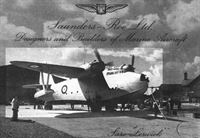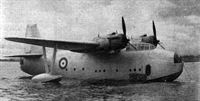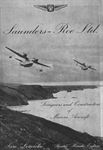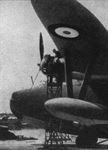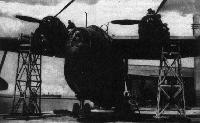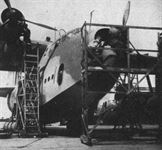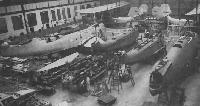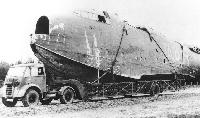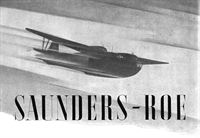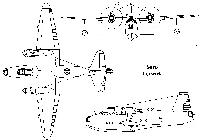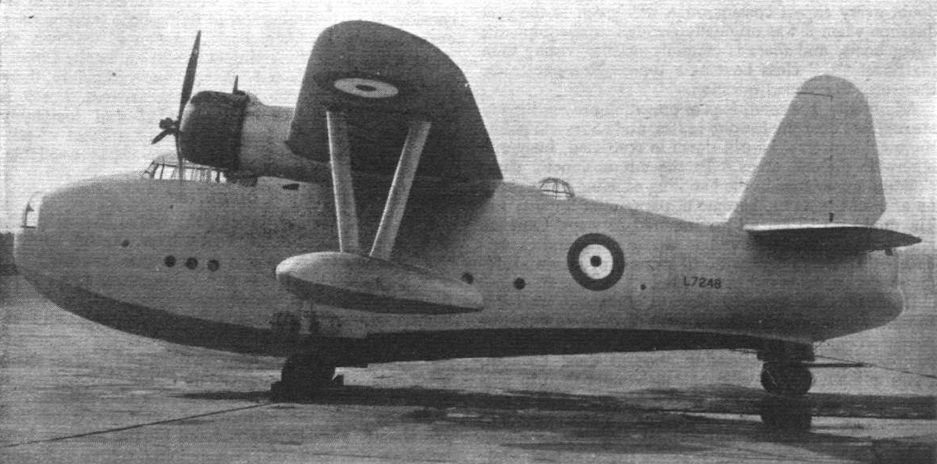
Lerwick / S.36
Летающая лодка, двухмоторный цельнометаллический моноплан. Спроектирована в КБ фирмы "Саундерс Роу" под руководством Г. Ноулера. Особенности конструкции - очень высокий фюзеляж, сдвигающаяся назад носовая турель и размещение части бомбовой нагрузки в отсеках мотогондол. Опытного образца не было, головной серийный S.36 появился в октябре 1938 г. Его испытания начались с первых дней ноября. Настоящее серийное производство началось с января 1939 г. на заводе "Саундерс Роу" в Ист-Коувсе. Всего построен 21 экз.
В конце 1939 г. ввели увеличенное вертикальное оперение, установленное затем на всех ранее выпущенных самолетах, на последней серии изменили угол установки подкрыльных поплавков. В мае 1941 г. лодки возвратили на завод для изменения угла установки крыла, в июле из-за опасных вибраций произвели ужесточение моторам на всех машинах, находившихся в эксплуатации.
Экипаж - 6 чел. Двигатели "Геркулес" II, на последних восьми лодках - "Геркулес" IV. Вооружение 7x7,69, бомбы до 900 кг (с перегрузкой - до 1400 кг).
"Лервик" состоял на вооружении строевых частей Берегового командования с декабря 1939 г. Применение этого самолета в войне было очень ограниченным. Только одну эскадрилью, базировавшуюся в Великобритании, полностью оснастили ими. Первое боевое патрулирование в Северном море совершили под Рождество 1939 г. Эксплуатация самолетов неоднократно приостанавливалась из-за необходимости доработок. Самолет считался сложным в пилотировании и неустойчивым. "Лервики" в основном вели поиск подводных лодок в Атлантике. 25 марта 1940 г. один из них атаковал бомбами немецкую подводную лодку, но безуспешно. Имели место еще несколько подобных случаев, но ни одна субмарина противника не была потоплена. Самолеты также участвовали в спасательных операциях.
Производство "лервиков" приостановили в октябре 1939 г., затем в феврале следующего года восстановили. Окончательно выпуск завершили в марте 1941 г. В конце мая 1941 г. эти лодки перевели в учебные части. Служившие там машины периодически привлекали к поискам экипажей сбитых самолетов. В августе-октябре 1941 г. "лервики" использовали для временного оснащения вновь формируемых эскадрилий. После этого большинство самолетов законсервировали, а в декабре 1942 г. списали. Одна машина служила как учебная до конца марта 1943 г.
"Лервик" I||
Размах:||24,64 м
Длина:||19,4 м
Моторы, количество х мощность:||2х 1375 л.с.
Взлетная масса, максимальная:||15000 кг
Максимальная скорость:||345 км/ч
Практический потолок:||4300 м
Дальность:||2800 км
Описание:
- Lerwick / S.36
- Saro S.36 Lerwick
- Flight, November 1939
Britain's Military Aircraft
Фотографии
-
Flight 1939-06 / Flight
Регистрационный номер: L7248 [11] Один из первых серийных "лервиков" на выкатном шасси
SOMETHING NEW FROM COWES: The Saunders-Roe Lerwick general-purpose flying boat (two Bristol Hercules fourteen-cylinder sleeve-valve radials of 1,400 h.p. or more) which is in production for the R.A.F. Following normal British practice, gun turrets are installed in the bow and stem and amidships. The Lerwick should be one of the world’s fastest flying boats and should have a tremendous range. -
Aeroplane Monthly 1979-01 / B.Gunston - The luckless Lerwick
Регистрационный номер: L7248 [11] The first prototype Lerwick, L7248. Note the original fin and rudder, wing floats without step and the absence of rear turret.
-
Aeroplane Monthly 1979-01 / B.Gunston - The luckless Lerwick
Регистрационный номер: L7248 [11] The first of the few, Lerwick prototype L7248 at Cowes shortly after completion, showing the original stubby fin and rudder. It is unarmed, has a dummy tail turret, and stepless floats.
-
Air-Britain Aeromilitaria 1988-02
Регистрационный номер: L7248 [11] L7248 on its beaching gear at the Marine Aircraft Experimental Establishment, Felixstowe, for trials
-
Air Enthusiast 2006-07 / G.Bussy - 'Forgotten' Flying-Boat /Flying-boats and floatplanes/
Регистрационный номер: L7250 [8] L7250 beached at Calshot in July 1939 while with 240 Squadron for trials.
-
Flight 1939-07 / Flight
FIRST IN SERVICE: A Saro Lerwick flyingboat is already being operated from the R.A.F. Station, Calshot. Each wing-tip float is mounted on two struts, which, while being flexible for shock-absorbing purposes, are claimed to be equal in strength to the normally braced type.
-
Air-Britain Aeromilitaria 1988-02
Регистрационный номер: L7248 [11] -
Air-Britain Aeromilitaria 1983-02
Регистрационный номер: L7250 [8] Saro Lerwick L7250 runs up on the slipway at Calshot shortly before the outbreak of the Second World War. Visible is the well-glazed cockpit which gave the pilots a good view of the whirring propellers in a position to neatly decapitate them if a blade came loose, a not-unknown event in any aircraft of the time. The portly hull had aerodynamic (and hydrodynamic) problems and the purposeful appearance of the Lerwick gave little hint of its rapid demise.
-
Flight 1940-07 / Flight Advertisements
Регистрационный номер: L7250 [8] A deep hull, sharply tapered wings and V-shaped float struts characterise the fast Saro Lerwick flying boat as now in service with the R.A.F.
The planing bottom of the Saro Lerwick shows how gradual changes as the result of experience have reduced the drag of flying boat hulls while still retaining good hydrodynamic properties. -
Aeroplane Monthly 1979-01 / B.Gunston - The luckless Lerwick
Регистрационный номер: L7250 [8] Lerwick L7250 during launch.
-
Air Enthusiast 2006-07 / G.Bussy - 'Forgotten' Flying-Boat /Flying-boats and floatplanes/
Регистрационный номер: L7250 [8] The third prototype, L7250 - going down the slipway with engines running on its beaching gear, with front turret retracted.
-
Flight 1939-09 / Flight
EMPIRE DEFENCE: One of the new Saunders-Roe Lerwick long-range flying boats (two Bristol Hercules) which will be used for oversea reconnaisance, patrol and bombing. The Lerwick is amongst the fastest flying boats in the world and is exceptionally well defended.
-
Aeroplane Monthly 1979-01 / B.Gunston - The luckless Lerwick
Регистрационный номер: L7249 [2] The second Lerwick, L7249, taking off at Cowes in 1939. Note the primer finish on the newly-modified rudder.
-
Flight 1940-03 / Flight
A Saro Lerwick (two Bristol Hercules), another standard type in the R.A.F.
-
Air Enthusiast 2006-07 / G.Bussy - 'Forgotten' Flying-Boat /Flying-boats and floatplanes/
Регистрационный номер: L7250 [8] Lerwick L7250, the third prototype, during sea trials.
-
Aeroplane Monthly 1985-03 / L.Coombs - The expanding years 1936-1939 (5)
A Saunders-Roe Lerwick high-speed, long-range Service flying boat powered with two Bristol Hercules fourteen-cylinder, two-row sleeve-valve engines designed by Mr. A. H. R. Fedden.
The Saro Lerwick's brief use with Coastal Command began in 1939 and ended in 1941 when it was superseded by the Catalina. -
Air Enthusiast 2006-07 / G.Bussy - 'Forgotten' Flying-Boat /Flying-boats and floatplanes/
Регистрационный номер: L7250 [8] L7250 in flight, with the final rudder profile.
-
Aeroplane Monthly 1979-01 / B.Gunston - The luckless Lerwick
Регистрационный номер: L7250 [8] Lerwick L7250, the third of its kind, served with 209 Squadron, 4 OTU and 422 Squadron RCAF during its life. It was finally left unserviceable at Pembroke Dock on October 19, 1942.
-
Flight 1939-11 / Flight
SEA PATROL: A Saunders-Roe Lerwick flying boat (two Bristol Hercules) over a familiar coastal land mark.
-
Air Enthusiast 2006-07 / G.Bussy - 'Forgotten' Flying-Boat /Flying-boats and floatplanes/
Регистрационный номер: L7249 [2] Lerwick L7249 with final rudder format.
-
Aeroplane Monthly 1979-01 / B.Gunston - The luckless Lerwick
Регистрационный номер: L7253 L7253 at Calshot in January 1940, as WQ-F of 209 Squadron. It crashed on February 20, 1940, and was written off.
-
Flight 1940-12 / Flight
Unusual features of the Lerwick (two Hercules) are the very deep hull and the small tapering wings.
-
Aeroplane Monthly 1979-01 / B.Gunston - The luckless Lerwick
MARINE MAJESTY: A fine impression of the lines and size of a Saunders Roe Lerwick long-range flying boat. Fitted with two Bristol Hercules sleeve-valve engines the Lerwick is outstandingly fast for a marine aircraft. Powered gun turrets are installed in the extreme bow and stern and on top of the hull.
A Lerwick out of water, with the beaching gear in evidence. The problems of engine access with a beached high-wing flying boat are amply demonstrated by the “siege tower” beneath the port wing. -
Моделист-Конструктор Гидросамолеты Второй мировой войны
Техническое обслуживание "Лервика" на берегу
-
Flight 1940-09 / Flight
OUR FASTEST FLYING BOAT: A Saro Lerwick being overhauled and serviced after a period of convoying, submarine spotting and other coastal reconnaissance duties. Our Service and civil flying boats are the envy of the world.
-
Air Enthusiast 2006-07 / G.Bussy - 'Forgotten' Flying-Boat /Flying-boats and floatplanes/
A Lerwick of 209 Squadron moored at Oban, with Short Sunderlands in the background.
Другие самолёты на фотографии: Short Sunderland / S.25 - Великобритания - 1937
-
Air Enthusiast 2006-07 / G.Bussy - 'Forgotten' Flying-Boat /Flying-boats and floatplanes/
Регистрационный номер: L7257 [4] L7257 'WQ-F' of 209 Squadron at Oban. The front turret is retracted for mooring.
-
Моделист-Конструктор Гидросамолеты Второй мировой войны
Регистрационный номер: L7257 [4] "Лервик" на базе 209-й эскадрильи в Обэне. Носовая турель в убранном положении
-
Мировая Авиация 230
Летающая лодка Saro Lerwick Mk I из 209-й эскадрильи. Она была недостаточно надежной в эксплуатации.
Экипаж Lerwick состоял из шести человек, а вооружение включало один пулемет Vickers K в носовой установке, пулеметы Browning в верхней (два) и хвостовой (четыре) турелях и до 907 кг бомб. -
Air Enthusiast 2006-07 / G.Bussy - 'Forgotten' Flying-Boat /Flying-boats and floatplanes/
Регистрационный номер: L7265 Lerwick L7265 'WQ-Q’ of 209 Squadron on the step at Oban.
-
Air-Britain Aeromilitaria 1988-02
Регистрационный номер: L7257 [4] Lerwick L7257 'TA-S' of No.4 OTU, Evanton, September 1941
-
Air-Britain Aeromilitaria 1988-02
Регистрационный номер: L7248 [11], L7252 [3] Original and revised rudder shapes on L7248
-
Air-Britain Aeromilitaria 1988-02
Регистрационный номер: L7252 [3] L7252 goes into hastily-applied camouflage at the outbreak of war and loses its serial
-
Air-Britain Aeromilitaria 1988-02
Регистрационный номер: L7248 [11] -
Air-Britain Aeromilitaria 1988-02
Регистрационный номер: L7248 [11] Detail of the rear fuselage of L7248 during the tail layout trials. Note the final form of the rudder, the large finlets and the tufting.
-
Air-Britain Aeromilitaria 1988-02
Регистрационный номер: L7248 [11] L7248 with twin fins and rudders on the water at Helensburgh
-
Air-Britain Aeromilitaria 1988-02
Регистрационный номер: L7248 [11] Moored at MAEE Helensburgh, L7248 showing off the twin fin and rudder modification.
-
Моделист-Конструктор Гидросамолеты Второй мировой войны
Регистрационный номер: L7248 [11] Опытный образец "Уолрэса" II с деревянной лодкой, Ист-Коувс, лето 1940 г.
The prototype Walrus II, X1045, photographed at the premises of Saunders-Roe in East Cowes. Moored behind is Lerwick L7248 wearing temporary twin fins and rudders.Другие самолёты на фотографии: Supermarine Walrus/Seagull V - Великобритания - 1933
-
Flight 1940-01 / Flight
Регистрационный номер: L7252 [3] PATROL BOATS: Lerwick high-speed long-range flying boats in production at the Saunders Roe works. They are fitted with two Bristol Hercules sleeve-valve engines and have gun turrets in the bow, approximately amidships and in the stern. This picture contravenes several Air Ministry regulations, but has been passed by the Censor.
Early Lerwicks under production, with L7252 behind. -
Jane's All the World Aircraft 1980 / Encyclopedia of Aviation - Aircraft A-Z - v5
Saro Londons, Lerwick (right) and R2/33 (left) under construction.
Другие самолёты на фотографии: Saunders-Roe A.33 - Великобритания - 1938Saunders-Roe London / A.27 - Великобритания - 1934
-
Flight 1939-07 / Flight
SIR KINGSLEY WOOD inspecting one of the Lerwicks at the Saunders-Roe works. The Lerwick has two Bristol Hercules engines driving de Havilland constant-speed airscrews and has the following measurements: length 63ft., span 81ft. and height 20ft.
-
Air Enthusiast 2006-09 / Round-Out
Регистрационный номер: L7257 [4] Peter Green has sent in this view of Saunders Roe Lerwick L7257 'TA-R' of 4 Operational Conversion Unit. We featured the Lerwick AZ125 and recorded that L7257 sank at its moorings at Ivergordon on November 11, 1941. Despite the considerable efforts required, it was clearly salvaged, albeit for spares recovery. As Peter says, it shows just how versatile 'Queen Mary' transporters were. He noted that the trailers had a load capacity of 3 tons, though a few were upgraded to 4 tons. He wonders how much a stripped-out Lerwick fuselage would weigh.
-
Aeroplane Monthly 1983-03 / W.Clarke - Drawing a bead (2)
THis drawing illustrates the Type GJ.3 sight mounting on a Nash and Thompson F.N.12 turret of a Lerwick flying boat. A knob on the right side operated a variable resistance to control graticule brightness for night use.
-
Air Enthusiast 2006-07 / G.Bussy - 'Forgotten' Flying-Boat /Flying-boats and floatplanes/
Saro Lerwick I. bottom right: Prototype L7248 initial format, centre: Twin fins and rudders as fitted with L7248
- Фотографии








